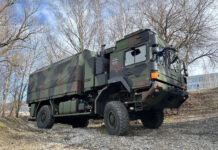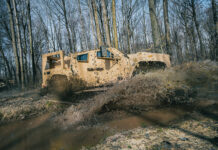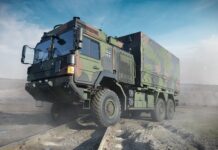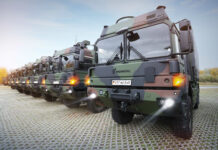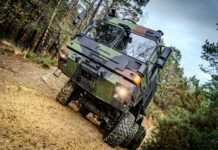In July 2024, Rheinmetall MAN Military Vehicles (RMMV) hosted a recovery capability focused event at the company’s main production facility in Vienna, Austria. While primarily for users and potential users of RMMV’s recovery solutions, the final session of the event was set aside for a small group of invited military-specific journalists. Here, the company demonstrated the capabilities of its latest Miller-equipped recovery trucks.
By way of background, RMMV is a 51/49% 2009-created joint venture (JV) between Rheinmetall and truck maker MAN (Maschinenfabrik Augsburg-Nürnberg). The JV originally encompassed all of Rheinmetall’s wheeled vehicle portfolio including armoured vehicles such as Boxer and Fuchs, but in 2019 it was restructured and now covers only trucks. MAN is now part of the Volkswagen-owned TRATON Group, along with Scania and Navistar.
RMMV’s JV agreement essentially has the company being responsible for all sales to military customers of MAN’s commercial product line, this including ‘white fleet’ (non-combat) vehicles. This bulk of these sales are for militarised medium weight TGM and the heavier-duty TGS, these collectively marketed by RMMV as TG-mil. TG-mil trucks are available with varying degrees of militarisation, this ranging from a relatively basic flat paint finish, rifle racks and a recovery points package through to higher standard electromagnetic compatibility (EMC) and electromagnetic interference (EMI) packages, a reinforced roof with circular hatch, and cold climate preparation. MAN’s lighter weight TGL and long haul-optimised TGX ranges can also be offered by RMMV as white fleet solutions, or with limited militarisation. Since 2017 a badge-engineered Volkswagen Crafter (the MAN TGE) has also been available, with a 2024-announced JV with Torsus of the Czech Republic adding a capability enhanced TGE to the portfolio.
RMMV’s truck offering is rounded out by the HX range, this a purpose-designed military truck. The HX truck was designed by MAN and is based around MAN’s automotive components. The design is considered the spiritual successor of the MAN Kat 1 high mobility trucks of the 1970s.

Credit: Miller Industries
The bulk of RMMV’s truck production occurs in Vienna at the former ÖAF-Gräf & Stift AG site. With a legacy tracing back to 1911, the facility now covers 95,000 m², of which 60,000 m² are built up. Over the course of 2024, the sites’ 1500 employees (of which >200 are engineers) will manufacture 2200 trucks on two production lines, increasing to 2600 in 2025. The technical capacity of the plant is 4000 trucks per annum, but this would require a two-shift system.
These production figures are quite interesting. The military truck market is far more peak & trough than its commercial equivalent, and using the UK as an example, the 2005 award to the then MAN ERF UK Ltd for the Support Vehicle contract would with around 7500 trucks replace a good 60% of the fleet of the time. However, there will be no serious attempt made to replace these trucks until the end of this decade, showing the often large time-lag between orders.
Commercially, MAN currently produces around 48,000 medium and heavy trucks annually, this giving the company a healthy 13% European market share, albeit a point or two behind rivals Daimler (Mercedes-Benz), DAF and Volvo. While military production, delivery and order figures are generally more difficult to obtain, RMMV’s figures give the company well in excess of a 40% European market share for the military segment, that figure increasing to circa 80% for the German home market.
RMMV’s Vienna facility produces TGS TG-mil and HX range trucks, but also handles the build of the most complex of MAN’s commercial offerings, the type of truck that would cause too much disruption on a modern ‘just-in-time’ semi-automated automotive production line. Quantities vary, but commercials that include STGO heavy tractor units, multi-axle chassis and other complex ‘specials’ can account for up to 20% of Vienna’s total output, these helping to level out those previously mentioned military troughs. Militarised TGM trucks, which are generally not militarised to the same levels as TGS, are now manufactured at MAN’s facility in Krakow, Poland, with production shifting to MAN’s new volume commercial facility following the sale of MAN Truck & Bus Austria and its production facility in Steyr during 2021.
In Vienna, trucks leave the main production line at a rate of between eight and 12 per day (dependent on mix and complexity), the production line deftly melds the labour-intense build of a military or ‘special’ truck with the best of MAN’s volume production know-how. The entire facility in fact echoes this melding, and while the likes of quality control and uniformity of finish is everything one would expect of a premium German-build vehicle, with its vast array of on-site engineering facilities and an engineering-biased (as opposed to assembly-biased) workforce, the impact of supply train glitches and the inevitable peaks and troughs of the military segment can in many cases be reduced by an on-site manufacture/fabrication capability for various component parts when required.

Credit: Shaun C. Connors
The second production line is reserved only for the most complex of trucks, examples here being the HX81 8×8 heavy equipment transporters (HETs) that are currently in production for Austria and Germany, or the five-axle 45M 10×10 recovery trucks for Norway, these leaving the line at a rate of between half and one truck per day.
The benefits of MAN’s involvement in the JV also stretches to in-service support. Users of RMMV’s trucks have access to MAN’s global support network, this including the novel ‘man in a van’ approach that operates in Germany and the UK (both of which have sizeable RMMV fleets). While primarily for commercial customers, if needed a technician can travel to any military vehicle with a complete package of diagnostic equipment and essential spare parts. In-theatre support is a further option. Looking ahead, and with MAN being part of TRATON and greater commonality between MAN, Scania and even Navistar inevitable, the global support available for RMMV-supplied trucks will increase accordingly, and potentially to previously ‘difficult’ markets such as the United States.
The hardware
RMMV’s recovery event also allowed for some informed insight into the ever-increasing difficulties of adapting a modern commercial truck such as the TG for military use, or indeed even using components/aggregates of commercial origin in a military-specific truck. While these difficulties are very real, and will only get worse, for certain there will never be a return to the days of a true military-specific truck using military-specific aggregates. For those old enough to remember, as examples of such vehicles, I give the Leyland Martian and the Alvis Stalwart.
Commercial trucks, like cars, are continually evolving, and with every passing year the levels of technology found in a truck increases considerably. This technology can range from something as ‘simple’ as a more environmentally friendly engine, right through to state-of-the-art electronic systems that start you, steer you, stop you, and do a lot of other things for you. While for the most part these updates are probably a good thing for the truck that delivers stock to your local supermarket, they’re definitely not such a good thing on a military truck when a military truck is doing what a military truck is designed for.
Some military users retain a pragmatic approach with regards to technology updates and so on, but others really do require what is essentially a supermarket delivery truck to be battle ready with little more than a coat of green or tan paint, and somewhere to put a rifle. This thought process can either be due to increased political pressures for compliance environmental and/or safety regulation, or it can be that those issuing requirements genuinely do believe that a supermarket delivery truck is pretty much ready and suited to military applications.
Fuel for thought
The term ‘simple’ is used here in context, but issues can be a simple as fuel type and compliance with emissions. Current-generation diesel engines feature highly complex electronic management and fuel additive systems to make them as fuel efficient as possible, while reducing emissions to an absolute minimum. Perhaps understandably, the military when deployed to theatres such as Afghanistan or Mali, have far more important fuel issues to consider than economy and emissions. It has long been a NATO requirement that for all the right tactical reasons that all ‘green’ vehicles are capable of running on aviation/jet fuel (F34/JP8). Jet fuel can contain up to 3000 ppm (parts-per-million) of Sulphur, while in comparison the low-Sulphur diesel most civilians obtain from the pump contains no more than 10 ppm of Sulphur.
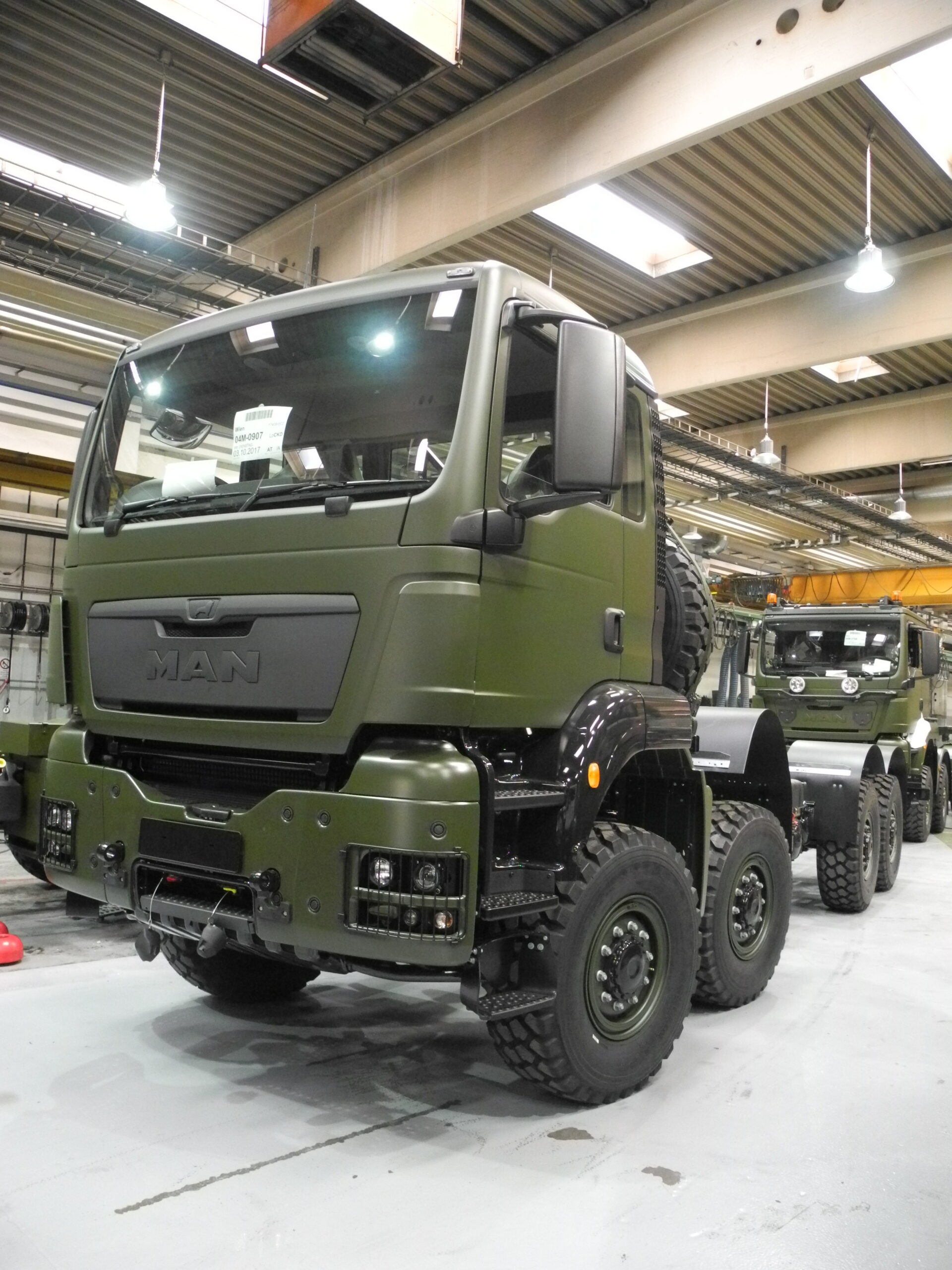
Credit: Shaun C. Connors
Any engine capable of running for extended periods on jet fuel will by design also be tolerant of poor-quality and lower-grade fuels, such as the types of fuels commonly found in the developing world, and where in recent years many NATO-grade/European militaries have found themselves deployed. This is problematic for newer engine designs, given that an electronically-controlled and emissions-compliant (currently EURO 6, with EURO 7 from 2027) engine optimised for low-Sulphur fuel, will simply not tolerate any other type of fuel for extended periods without damage and/or failure.
However, the wholly unrealistic demands for an engine that runs EURO 6 ‘at home’ but at the equivalent of a switch flick adapts seamlessly to F34/JP8 when required, and then back again to EURO 6 and having suffered no damage to the engine and/or fuel system are increasing. The sensible compromise here, which is becoming ever harder to reach, would be an engine rated at EURO 3 standards. The vast majority of EURO 3 engines are capable of running on high-sulphur/dirty fuels for extended periods, and it is a point of note that the reduction in emissions between EURO 3 and 6 is near-miniscule when compared to the drop between EURO 3 and no EURO standard compliance at all. Further supporting that EURO 3 compromise argument, one large container ship transporting disposable plastic goods from China to Europe, over the course of one trip, has a greater emissions footprint than 2000 EURO 3-rated military trucks covering 10,000 km each per annum.
Electronic systems, especially so-called driver aids, are another bane of those tasked with militarising a commercial truck design. While undeniably useful in a peacetime environment, tactically most of these aids become useless. When being seen is not an option, military vehicles have long had a simple blackout switch that, as its name suggests, extinguishes all light sources. In a truck or similar, the driver then slips on night vision goggles. For that same tactical environment the truck driver now needs to be able to neutralise not only lighting, but all audible warnings, while selectively being able to override braking, collision or any other driver or pedestrian/cyclist safety aids the user has opted to have, or been required to have, fitted. At its simplest, when push comes to shove the soldier may actually need to drive over or through an obstacle which assorted safety aids and other systems simply would not permit, or at the very least not without assorted visual and audio warnings.
There is also the added issue of ‘hardening’ to military standards – EMC, EMI, and even electromagnetic pulse (EMP) – all the cameras and sensors. Waterproofing of these for fording operations is yet another consideration, and that includes salt as well as fresh water. Such are the complexities here that by way of example it is now not economically viable to proof a TG truck for fording beyond commercial norms.
Recurring costs
A key issue with militarising a commercial truck is that this militarisation task is essentially never-ending. Using RMMV’s TG-mil as an example here, the current commercial TG is TG Generation 3 (TG3), this introduced in 2020 and now the baseline for all current TG-mil. As with most things commercial and automotive, facelifts or refreshes are a regular occurrence, and in 2022 TG3 received its first planned incremental update. It is receiving another in 2024 for MY25 trucks, and will receive a final one in 2027. For each of these updates, which are usually heavily legislatively-driven, and for the most part related to electronic architecture, militarisation has to be developed, and this is both time-consuming and expensive.
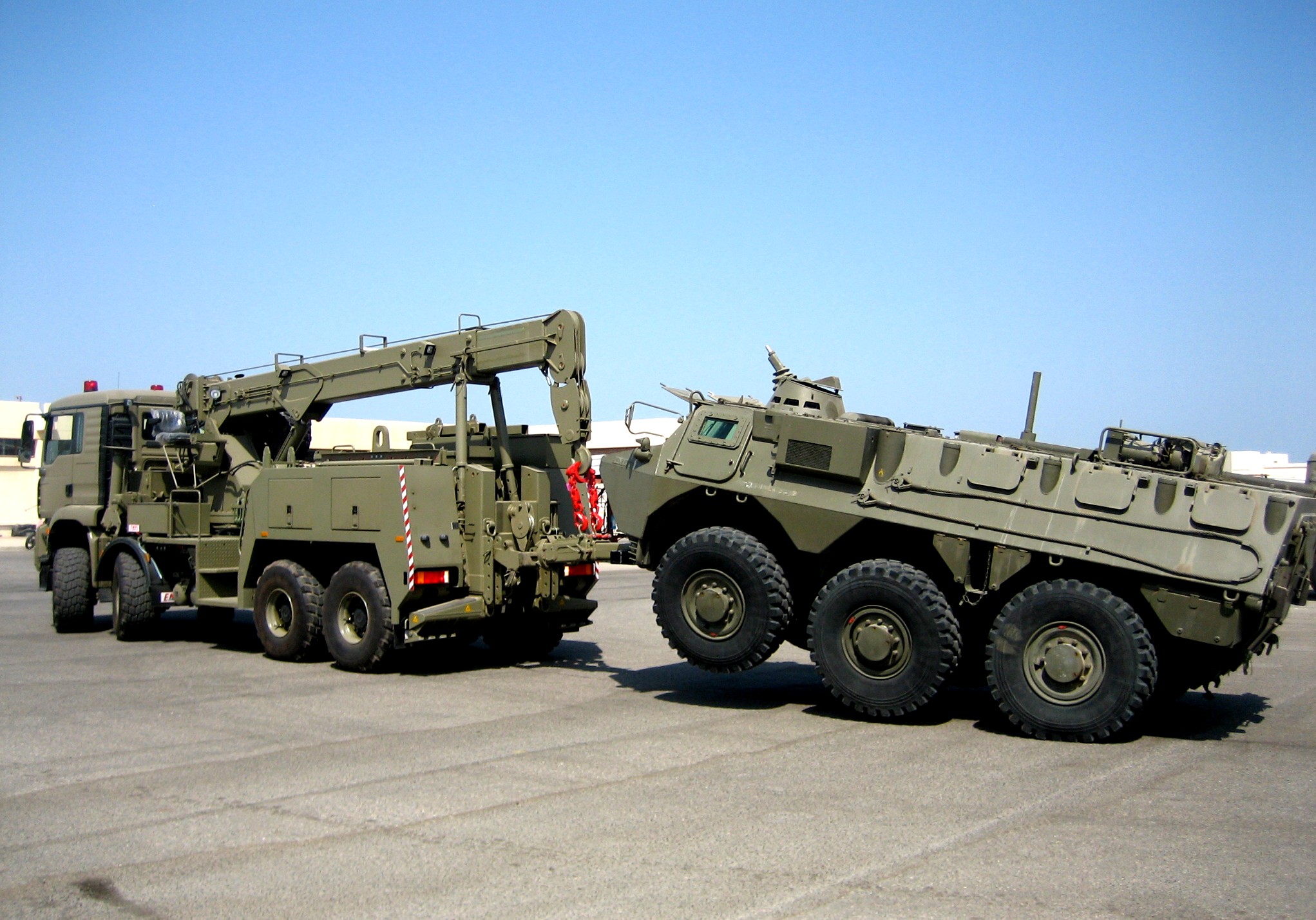
Credit: Shaun C. Connors
Another issue is timelines. Most commercial customers take deliveries across months, this even for sizeable fleet replacement orders. With the military, deliveries are more often across years, and this in itself creates further challenges. In 2014, taking a joint procurement approach, Norway and Sweden signed a contract with RMMV for TG-mil and HX trucks, for which orders could be placed until 2025, with deliveries following until 2027. A militarisation package that included EMC/EMI to military standards equal to those of an armoured fighting vehicle (AFV) was developed for TG Generation 2 (TG2), and primarily to meet the needs of the Norwegian customer. In fact, such are the costs and to a lesser degree lack of commonality implications of a recurring militarisation development process to these levels, that the Norwegian customer adopted a pragmatic approach and, having received a batch of TG2 TGS, will wait for further TGS deliveries until the full militarisation package is developed for TG3-based TG-mil around the MY25 update. This is scheduled to be the final significant electronic architecture update scheduled for TG3, but is unfortunately not the final scheduled update, which is due in 2027.
The current HX range of tactical trucks are based on TG2 and its electronic architecture, this including much of the TG’s instrumentation. To limit regular re-work primarily of electronic architecture, final development of next-generation HX trucks (HX3) was held back by RMMV so that TG3 MY25 updates could be adopted for this. However, even this approach will not eliminate all challenges. Currently, even after TG3’s 2022 update, ‘real’ (physical) switches remain, for driving modes, traction aids and similar. Along with the MY25 electronic architecture update, which will include a selection of advanced driver assistance systems (ADAS), will come considerably more touchscreen technology, this at the expense of most physical switches. While a yet-to-be-developed ‘mission mode’ switch will in theory enable any fitted ADAS or other undesirable ‘aids’ to be overridden when required, quite how things will work with a touchscreen in a blackout environment and by a soldier in Arctic clothing (including gloves) remains to be seen.
Then there is the TG3’s aforementioned 2027 update. This update is predominantly to comply with new Enhanced Direct Vision requirements, and while enhancing all-round visibility and removing potential blind spots from a truck operating in a busy urban environment is clearly a good idea, how will all that additional glazing (including in the side doors) fare in a military environment?
As previously noted, HX are RMMV’s tactical truck offering, and while they utilise MAN’s electronic architecture and automotive components, the chassis and cab are purpose-designed for military items. The chassis benefits from not needing to be a one-size-fits-all type design, such as one that is suitable for everything from tipper to curtainsider. The easy-to-repair, eminently practical box-like flat-panelled all-steel cab is curve-free and shows not a trace of ergonomic or aerodynamic styling, the design of which enables the fitting of an integrated steel front bumper and skid plate. In an excellent example of the ‘if it ain’t broke why fix it’ school of thought, the HX cab, while improved, is not that different to the cab fitted to the original Kat 1 trucks of the 1970s, and the flat split front windscreen remains a rare example of a military exemption being retained. A further benefit of the cabs’ flat panels, as opposed to curves, are that they readily accept armour in kit form. For more significant threats, a Rheinmetall-designed and produced armoured swap cab is available, this providing protection levels equal to those of some armoured personnel carriers (APCs).
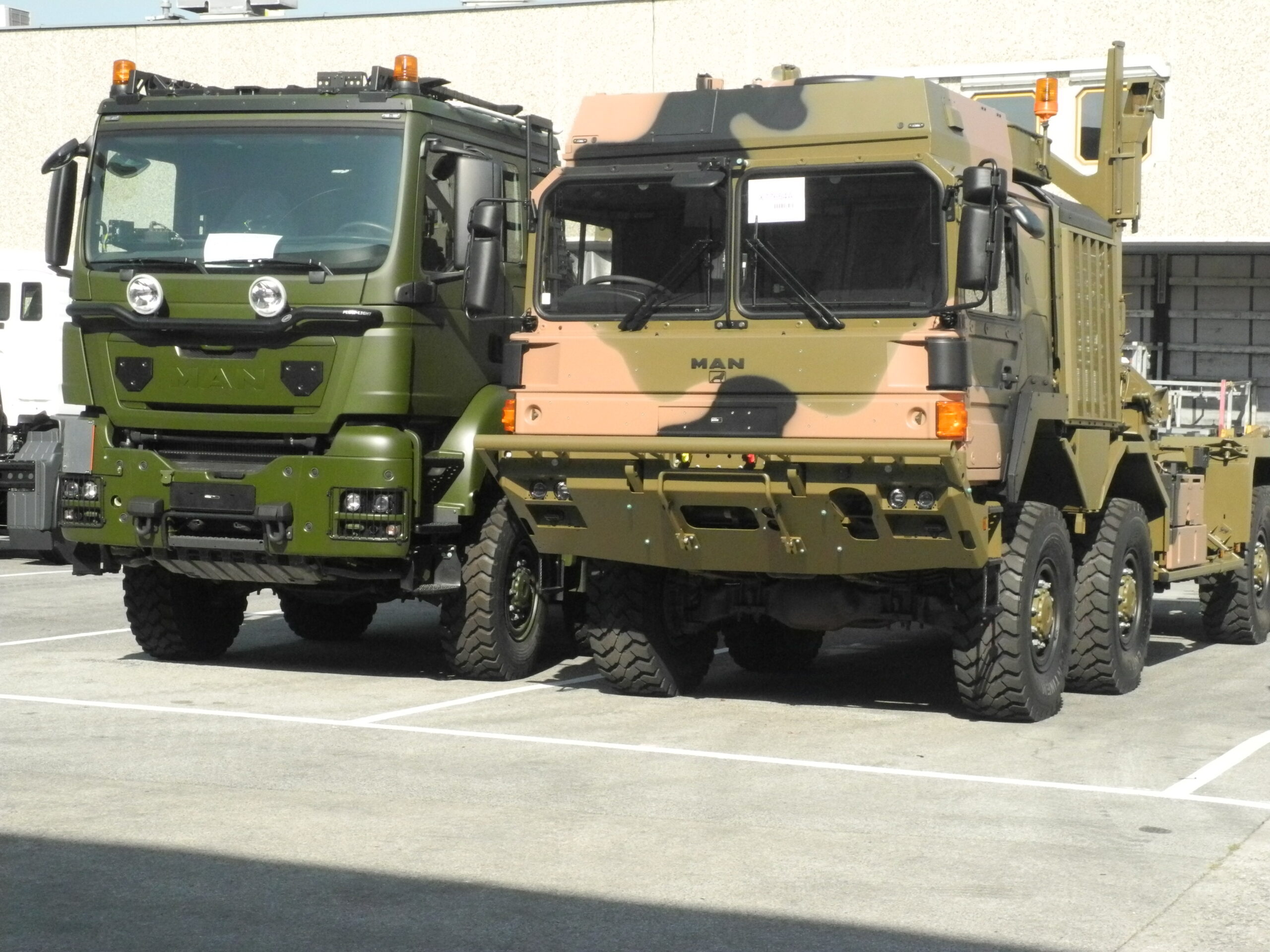
Credit: Shaun C. Connors
Another point of contention to mention on the militarisation topic would be the health and usage monitoring system (HUMS). Again, commercially, and even militarily for homeland roles, such systems can be nothing other than useful. There are however a number of challenges to overcome before any military fleet can be fitted with such a system. Least of all, adoption of a HUMS arrangement by any armed force would essentially require a full reset of existing maintenance and general fleet management thought processes and practices. Yet perhaps more importantly, there will be times when any HUMS fitted truck is best to not be transmitting any data (and potentially advertising its location), while the system itself, in addition to being militarised in the areas of EMC/EFI/EMP performance, also needs to be ‘hardened’ and cyber-secure for when transmission of data is acceptable.
Of course, all of the aforementioned and other similar issues are not exclusive to RMMV. They most definitely apply to any and all commercial truck manufacturers that offer a military product, and to a lesser but still significant extent, to any armoured vehicle produced that uses commercial-off-the-shelf (COTS) components such as engines.
Follow the leader
Before our look at the recovery assets on show at what was predominantly a recovery event, a quick mention of another displayed truck, and one in which the electronic technology may shortly offer the military user a genuinely valuable capability.
Vehicle autonomy is definitely a topic of the moment, but irrespective of some claims made, in the cold light of day, true full vehicle autonomy in any meaningful sense is still a very long way off. For those familiar with the 1990 Arnold Schwarzenegger film ‘Total Recall’, the Johnny Cab, or similar, will not be giving you a ride anywhere anytime soon. Realistically, we remain firmly in a world where an autonomous vehicle can be halted by a 50 mm deep puddle, for essentially the same reasons it would halt some horses.
However, a couple of steps before full autonomy is so-called leader-follower technology, and RMMV’s take on this was explained at the recovery event. With a manned truck at the front leading AI a convoy of trucks can follow one another, with RMMV suggesting that the system could be rolled out in some form by around 2030. There remain challenges of course, and while no autonomous system can currently even effectively ‘think’ to slightly change a driven line if a route is becoming heavily rutted, and would likely encounter problems should a hill climb be failed, at the rate AI is developing, these and many similar issues that are currently represent the chasm between human and AI capability will almost definitely no longer be.
Recovery
The full RMMV truck portfolio will accept a recovery body, from the lighter TGM TG MIL through to the five-axle HX45M. The majority of recovery trucks, or ‘wreckers’ to some, are on chassis with three-axles or more, and these are usually chassis with gross vehicle weight/gross combination weight (GVW/GCW) ratings above road-legal limits. Recovery bodies can be sourced from a selection of suppliers, although in recent years RMMV has tended to favour Miller of the United States, and predominantly for rotator configurations.

Credit: Shaun C. Connors
On show at the recovery event were three HX trucks, an Austrian Army 6×6 42M, an 8×8 44M Heavy Recovery Vehicle in what was believed to be Canadian Enhanced Recovery Capability (ERC) configuration, and a Norwegian Army 45M 10×10 Special Recovery Vehicle.
Recovery truck capability requirements vary considerably from one armed force to another and two trucks to be used to recover loads of essentially the same weights and dimensions can, depending on user, actually end up being specced and looking quite different. The Austrian Army’s displayed 42M 6×6 is probably even more user-specific than most.
Packaged and delivered by EMPL of Austria, the 24 medium recovery vehicles (mittleres Bergefahrzeug HX2 (mBgeFzg)) delivered to the Austrian Army in 2022 cost around EUR 1 million each. These 27.6 tonne trucks (78 tonne GCW) are fitted with a rear-mounted Palfinger 41002EH materials handling crane rated at 36 t/m (equating to 3.8 tonnes at 9.5 m of extension). This crane was specified for use with a purpose-designed hydraulic balancing bar/frame rated at 5 tonnes, this for lifting vehicles and the handling of the EMPL swap bodies fitted to the Austrian Army’s TGM fleet. The EMPL underlift which extends to 2.17 m is rated at 8 tonnes, this enabling the truck to recover Austrian Army KMW Dingo armoured vehicles. Twin 12 tonne Sepson winches are fitted, these have 60 m of cable and, in addition to recovering bogged down vehicles, can be used to haul disabled vehicles onto a companion recovery trailer. These four-axle trailers were supplied by EMPL in cooperation with DOLL of Germany. To RMMV, the Austrian truck is designated the 42M 6×6 Light Recovery Vehicle.
The 44M 8×8 Heavy Recovery Vehicle and 45M 10×10 Special Recovery Vehicle (RMMV designations) shown at the event were both fitted with Miller recovery bodies, and despite the obvious axle configuration difference, the recovery packages were almost identical, based around a Miller 1050M rotator and a Rotzler TR200 capstan-type main winch. As a capstan-type winch, the main recovery winch has a constant 25 tonne single line pull for 103 m of cable, this in double line pull configuration easily allowing for recovery of relatively heavy vehicles such as the Boxer 8×8. The Miller rotator is fitted with twin Tarvos TA15 drum winches, these rated at 10 tonnes on the bottom layer and 6.6 tonnes on the top layer. For self-recovery, a single winch can be deployed to the front of the truck.
The rotator set-up is relatively new in the recovery world, originating in the US and making initial market inroads in the mid-1990s. An evolution of sorts of the Holmes-type twin-boom wrecker, a rotator, as its name suggests, has a boom that rotates a full 360 degrees, allowing for a recovery pull in almost any direction. Even without an extending boom option, a standard rotator offers the benefit of height/lift with any recovery pull, and when used in conjunction with the main winch a single vehicle can recover a roll-over casualty in a controlled manner.

Credit: RMMV
The rotator was never designed as a crane, and while technically still not a crane, a vertical lift capability is now part of standard specification, and the rotator is covered by crane legislation within the EU. The Miller 1050M has a 10 m extending boom and user requirements it needed to meet included a 32/21 tonne in/out vertical lift capacity for Australia (45M), and a 16 tonne capacity at 6 m (20 ft) for Norway (45M). The latter was essentially not strictly a recovery task, but to be capable of handling fully laden/kitted out 20 ft ISO containers. Technical lift capacity of the 1050M is 45 tonnes.
The final part of the recovery package fitted to these trucks is an underlift, this rated at a hook load capacity of up to 15 tonnes. Again, this is sufficient for the towed recovery of a Boxer. Maximum extension from the centre of the rearmost axle for the underlift is 4.7 m (44M) or 4.2 m (45M). The 44M has a GVW of 38 tonnes, this increasing to 41 tonnes when an armoured cab is fitted. The 45M has a GVW of 40.8 tonnes, this increasing to 43.8 tonnes when an armoured cab is fitted. GCW for both trucks is 75 tonnes.
The two trucks are as previously noted essentially identical in terms of spec, including automotives based around a MAN 12.4-litre, six-cylinder, EURO 5 rated D26 diesel developing 402.7 kW (540 hp) and coupled to a ZF seven-speed fully automatic transmission. The main automotive differences are drive axles and suspension, the rear tridem of the 45M having hydropneumatic suspension (with a lock-out feature) as opposed to the more conventional longitudinal inverted trapezoidal leaf spring set-up of the 44M. The fifth axle of the 45M contra-steers giving the 11.6 m long vehicle a slightly better turning circle than the 10.9 m long 44M. Tyres, a more important consideration than one might at first imagine, can be 395/85 R 20 or 16.00 R 20. Run-flat inserts and a central tyre inflation system (CTIS) are options.
Customers’ differing desires/demands are again clearly highlighted in these recovery trucks which as previously noted have very similar recovery capabilities. Pricing will of course be a key driver for some, with the 44M (with an armoured cab) coming in at a unit price of around EUR 2 million, about EUR 0.5 million less than the larger 45M.
In terms of mobility, both trucks can ford 1.5 m of water, cross a 1.4 m wide trench, and at GVW climb a gradient of at least 60%, and traverse a 30% side slope. Climatic operational range is -32°C to +49°C. However, its overall weights/dimensions notwithstanding, with comparable tyres the 45M would in most cases be the more mobile of the two trucks. The extra axle is key here, reducing those all-important axle loads for soft ground mobility.

Credit: Shaun C. Connors
The Australians and the Norwegians both currently operate the HX45M, with a Norwegian truck shown at the RMMV event. Both Australia and Norway opted for a EURO 5 emissions-compliant engine, and despite a non-emissions-compliant option being available. Visually it is very clear the two trucks differ in tyre choice. For mobility, Australia opted for the larger 16.00 R 20 tyres, these when compared to the 395/85 option improving approach, departure and ramp breakover angles, increasing ground clearance and tyre footprint, while reducing overall ground pressure. Norway’s 45M as opposed to 44M decision is understood to have been mainly legislatively-driven, and primarily for axle loading compliance when towing a casualty. These loadings were achievable with smaller-diameter (and cheaper) 395/85 R 20 tyres, and these are fitted. Other ‘benefits’ of 395/85 R 20 tyres opposed to 16.00 R 20 tyres are reduced overall height (when keeping below the EU 4 m regulation is deemed important), and a reduced turning radius (when meeting the EU regulation outer circle 12.5 m radius requirement is deemed important).
The 44M Heavy Recovery Vehicle shown at RMMV’s event was understood to be in a configuration for Canada. RMMV could not confirm this, but ESD sources suggest that Canada’s long-awaited Enhanced Recovery Capability (ERC) has been awarded to the company. Sources also suggest that RMMV ended up being the sole bidder for an already over-complex requirement that was further complicated by the need to comply with the widely-varying road and operating regulations across Canada’s ten provinces.
The 44M has also been supplied to New Zealand and Singapore with a Miller-supplied recovery package. Compared to the Canadian 44M, these trucks, which are designated 44M Medium Recovery Vehicle by RMMV, are fitted with a lower-powered 440 hp D20 engine, this again rated at EURO 5. Tyres are 395/85 R 20. With the exception of the Miller 1130 rotator, which has a shorter extension and slightly reduced lifting capacity compared to the Miller 1050M on the Canadian example, in all other recovery equipment areas these and the Canadian truck are essentially the same.
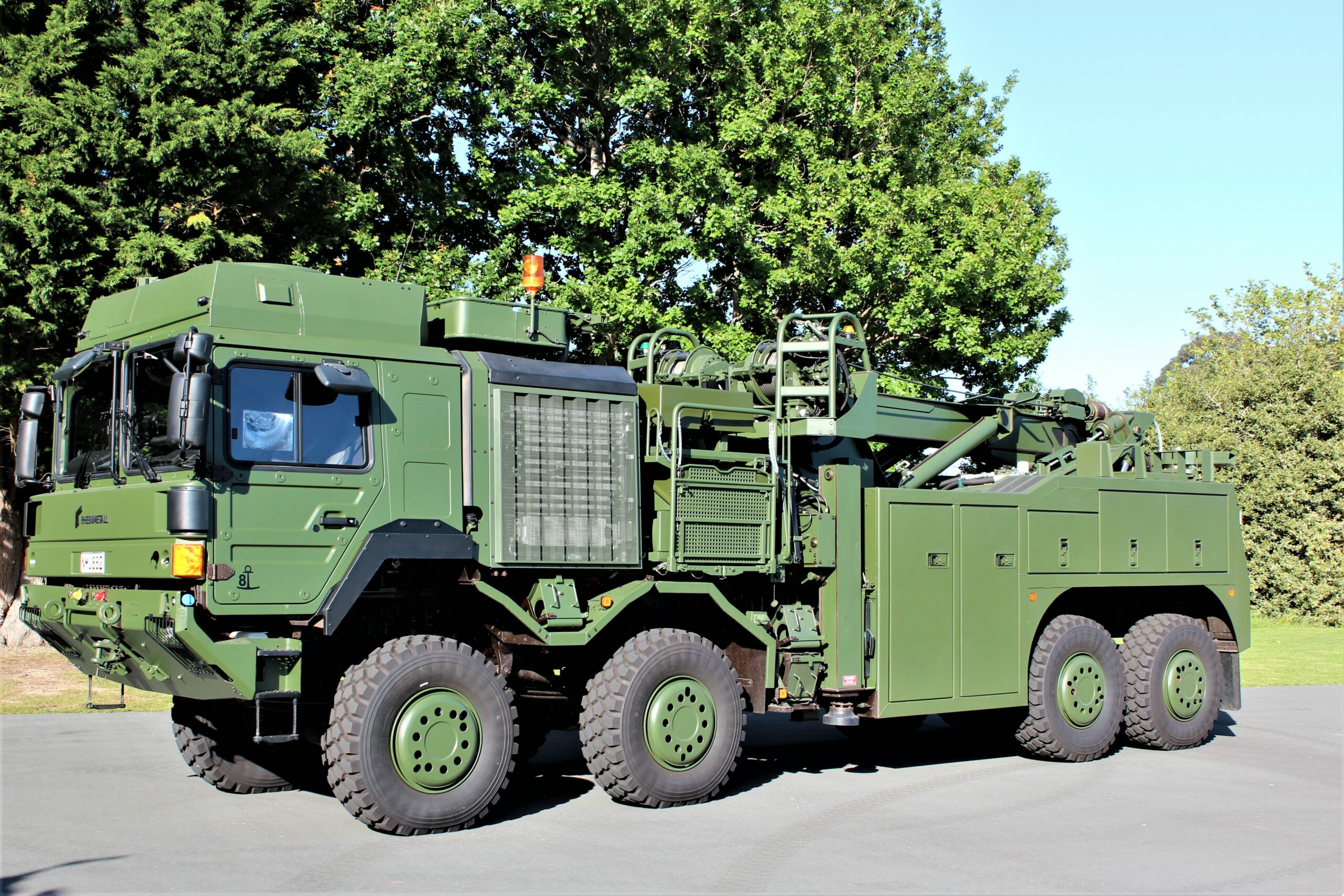
Credit: RMMV
For all the obvious reasons a rotator-type recovery package is now becoming a more common choice than one using a conventional vertical lift crane, and certainly in the commercial sector. The military, traditionally conservative and ‘late to the party’ (for the right reasons in most cases) for such a capability evolution are now most definitely looking more closely at the rotator as a recovery option.
The first known European military customer of a rotator-type recovery package on a tactical truck was Denmark, which in 2013 ordered 14 RMMV SX45 with a Miller-supplied package. Interestingly, and despite its US origins and very sizeable home market share, the US military has yet to adopt a rotator-based package for any of its tactical truck-based recovery assets, these on the FMTV, HEMTT, MTVR and LVSR. In Europe, RMMV while continuing to offer variously configured recovery packages on TG-mil and HX trucks, is clearly actively promoting the rotator, with Germany and the UK understood to be markets of interest.
Food for thought
For essentially as long as they have been used, when an armoured vehicle is developed for and delivered in any quantity to an armed force, a recovery and/or recovery and repair variant usually follows as either part of a family of variants, or even as a lone specialist variant. Taking the British Army as an example, there were separate Warrior repair and recovery variants, a CVRT recovery variant, a Challenger 2 MBT repair and recovery variant, and most recently there are separate repair and recovery variants of Ajax. However, just because historically ‘like recovers like’ has been the default assumption, does it mean there it must always be?
The Boxer 8×8 armoured vehicle has been supplied to or is on order with (among others) Australia (211), Germany (550, with more probable), The Netherlands (200), and the UK (623, with more probable). While Boxer’s swappable mission module design has allowed for somewhere in the region of 20 mission module configurations to be placed on contract (and well over 30 proposed), as yet no Boxer user has a recovery or even repair/recovery module in production or service. Australia is understood to be developing and considering separate repair and recovery modules, while both Germany and the UK have openly acknowledged the need for a Boxer recovery (and repair) capability.

Credit: Miller Industries
To meet this need RMMV, is actively promoting the 45M Special Recovery Vehicle as delivered to Australia and Norway, this easily capable of winch recovering, uprighting, and suspend towing a Boxer, the latter possibly with some peacetime limitations on highways. The vertical lift capacity of the rotator also allows for the handling of individual Boxer modules.
Within the region of 13 to 14 tonnes of total payload available (including module structure) there is no possibility of integrating this complete capability into one Boxer module, hence the two-module route Australia is exploring. If one were to outfit a Boxer module with a main winch capable of recovering a bogged Boxer, the available ‘payload’ left over for a crane would be insufficient for anything near that of the rotator fitted to the 44M/45M. Conversely, fitting a crane of comparable capability, would likewise reduce the winch capacity. Additionally, neither of these options factors in an underlift capability, which would almost certainly not be something that could be fitted to a Boxer.
It is true that the 45M is longer overall than a Boxer and, when fitted with an armoured cab, around 5.3 to 7.3 tonnes heavier (depending on the Boxer configuration), however, mobility is unlikely to be an issue. When fitted with 16.00 R 20 tyres, ground pressure drops as individual axle loads are around 10% lower than those of Boxer in the heavier A2/A3 (mixed) and A3 configurations (as supplied to Australia and the UK respectively), and are just under 5% lower than Boxer in its lightest A1 and A2 configuration (as supplied to Germany, Lithuania and Netherlands). ESD sources report that in an unofficial comparison a 45M successfully followed a Boxer off-road evaluation and demonstration route. Fording, gradeability and climatic operational range are all comparable.
Detractors from the idea of abandoning what has always been regarding a recovery variant might point out that the truck’s armoured cab does not provide a level of protection equal to that of Boxer, and that only the crew compartment itself is protected. Both of those statements are true, and while zoned protection for areas such as fuel tanks, air reservoirs, radiators and battery boxes is always an option, by its very nature a recovery operation would generally not be carried out under direct fire. Detractors might also say that a truck adds to any logistic burden as the HX range has no significant component commonality with Boxer. This is also correct, but the Australians, British and German armed forces each operate thousands of RMMV HX trucks. That one fact also mitigates the training and driving argument, as it is probably fair to say that if you are qualified to drive a Boxer, if push ever came to shove, you could almost certainly drive an HX truck.
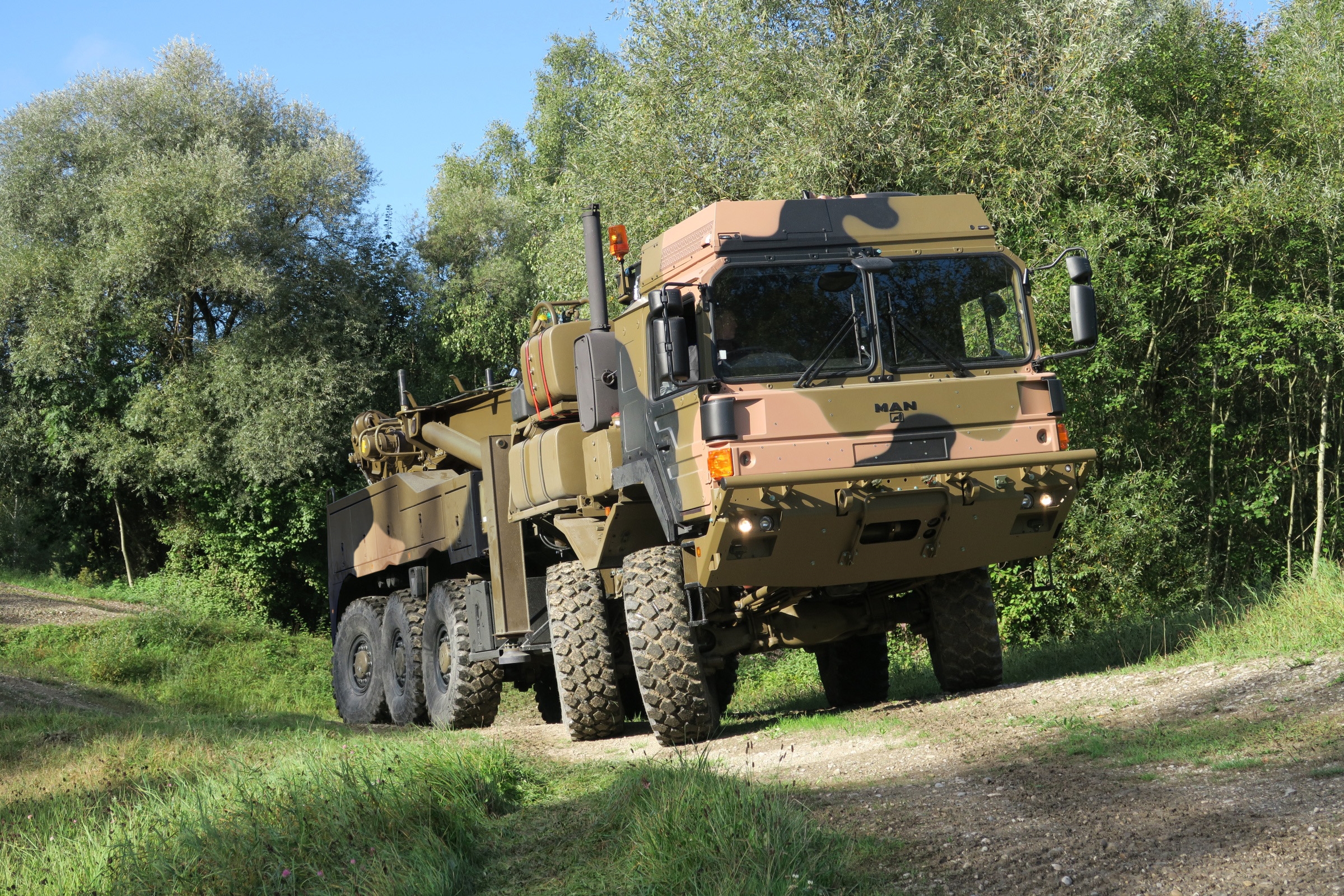
Credit: RMMV
Yet possibly the clinching argument for the 45M-based solution is that of cost. While obtaining exact pricing information for such things is always difficult, a figure of EUR 2.5 million for an 45M Special Recovery Vehicle is that generally quoted and believed to be reasonably accurate, while the most conservative figure quoted for a Boxer in recovery/repair configuration is around the EUR 10-12 million mark. With a price difference as stark as this, the case for abandoning the long-held tradition of ‘like recovers like’ appears fairly convincing.
Shaun Connors




